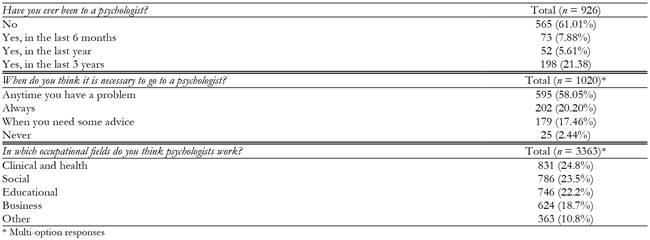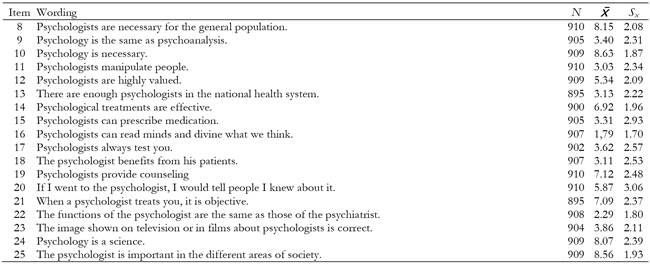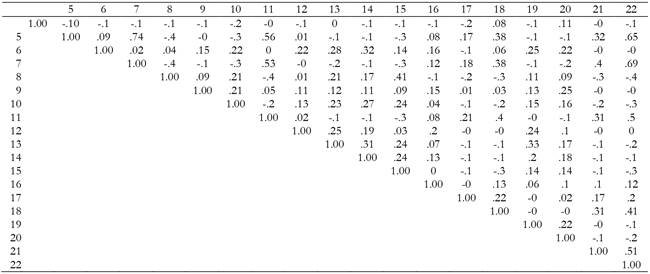Introduction
Many years have passed since psychology became part of the curriculum at Spanish universities and it was first offered as a degree course in its own right. Key dates are 1949 for the creation of the Department of Experimental Psychology at the Higher Council for Scientific Research, 1952, when the Spanish Psychological Society was founded, or 1968, the year when a degree in Psychology was first offered at the Universities of Madrid and Barcelona (Siguán, 1977).
From the 1970s onwards, psychology gradually began to emerge from the guardianship of Philosophy, for example at the Autonomous University of Madrid with an innovative curriculum in the Faculty of Philosophy and Letters, where all courses from the second year on were focused purely on aspects of psychology (Blanco, 2001). As Psychology began to be offered at more spanish universities (Granada in 1974 and Murcia in 1975), important curriculum changes were introduced in the 1970s and 1980s, with changes to the study programmes and the development of specialisations, first with the development of the degree (licenciatura) in Psychology and later with the degree (grado, post-Bologna) in Psychology as of 2009 and the development of the master’s in General Health Psychology as of 2014.
In Spain, the practice of psychology began to develop in the 1960s and became institutionalized at the end of 1979 with the creation of the Official College of Psychologists, which by law restricted practice to Psychology graduates (and those with other officially approved qualifications) who were also enrolled in an Official College of Psychologists (Santolaya, 2012).
According to Alcaín and Ruíz-Gálvez (1998), the study of publications in psychology journals offers a better understanding of the development and the current state of the discipline, especially from the perspective of research. The results obtained by these authors in an analysis of the 104 journals specialised in psychology from the 1970s to the 1990s show that psychology in Spain is a discipline which has been developing throughout that studied, with greater growth during the 1980s and remaining more or less stable after 1990. The development of the discipline is shown in the appearance of journals for different specialisations and in the disappearance of general interest magazines. It can be seen that psychology is a constantly evolving discipline, keeping itself up to date and with a special interest in increasing the dissemination of its research results (Alcaín & Ruíz-Gálvez (1998).
Thanks to these important developments, psychology in Spain has managed to become part of the social fabric and currently enjoys a status unthinkable only a few decades ago. Today, there is practically no discipline or field of knowledge which does not require the presence of a psychology professional.
Nevertheless, studies on the image of psychology today among the Spanish population are scarce. Buela-Casal et al. (2005) analyse the perception of psychology linked to the health profession and the demand for mental health care by means of a survey in all provinces of Spain, taking into account sex, age and profession. Key results were a clear preference of the population to turn to a psychologist in cases of emotional upset, emergency or disaster, with a clear tendency in favour of consulting a psychologist (percentages above 50%) as opposed to a psychiatrist (values below 50%) (Buela-Casal et al. 2005).
At the professional level, according to the study on the situation of clinical psychology in the Community of Madrid, the figure of the psychologist enjoys great recognition in the clinical field, being positively valued both in primary and in different areas of specialised care (psychiatry, neurology, oncology, cardiology, gynaecology, etc.) (Duro, 2016).
Notwithstanding the above, we find that we do not have a current benchmark to guide us as to the opinion and knowledge of the Spanish population with regard to either the figure of the psychologist in general, or to their work and their way of working in particular. In many cases, opinions can only be found on blogs, forums and other internet sites. Such opinions are often no more than first impressions, based on very little objective information. However, we know from social psychology that these first impressions can have strong and stable effects on the perceptions other people have of us; they can also exert powerful effects on the behaviour towards our collective due to the way in which the population perceives us (Baron & Byrne, 2005). It is evident that the process of perception does not occur in a social vacuum; rather, social perception and interaction are inseparable, resulting in a dynamic context of interaction (Cantillo & Bueno, 2012).
An orientation in this regard can enhance the way we make this profession known in a deeper and more realistic way, thus opening the work of psychology more broadly to society as a whole.
Objective
The general aim of this study is to describe the opinion of Spanish society today of psychology, focusing both generally on psychologists as a collective and specifically on their work and position in society. In terms of specific objectives, sample characteristics will be described and response patterns will be analysed for cluster tendencies.
Method
Study design
This is a descriptive and correlational study. This type of design is used in the early stages of research studies to obtain a diagnosis of the situation which guides future interventions or experimental studies.
Participants
The sample in the present study comprised 920 people, and sampling proceeded by the incidental method. This is a non-probabilistic type of sampling method, where individuals are chosen by chance, without applying any selection criteria. Given this type of selection, it is clear that samples may be unrepresentative; these samples are based on general assumptions about the distribution of the variables in the population. Nevertheless, non-probabilistic surveys should not be undervalued. They should be presented with their original characteristics, and if correct and adequate use is made of them, their results are in general useful and indicative (Pimienta, 2000).
Assessment/Measurement tools
A specific survey was designed for the purpose of this study. The survey draws on an activity used by students on courses in their Psychology degree at a Spanish university. In this activity, qualitative information was sought about the image and/or prejudices of the population regarding psychologists. Based on this information, a first survey design was then drawn up. A group of experts significantly subsequently reduced the number of questions due to content overlap and refined their wording.
The final version of the questionnaire consisted of a total of 25 questions covering opinions about psychology, about how the profession works and about aspects of its implementation in society. Of these 25 questions, 18 are answered on a 10-point Likert-type scale. Likert-type scales provide a simple method because of their ease of preparation and application; their characteristics are not inferior to other types of scales, locating each individual at a certain point and taking into account the breadth and consistency of attitudinal responses (Elejabarrieta & Íñiguez, 2000; Morales, Urosa & Blanco, 2003). The four remaining questions are of a qualitative nature, asking for a description of the psychology professional, whether the respondent has visited such a professional at any point, the occupational fields in which psychologists can work, and under which circumstances it is considered necessary to consult a psychologist.
Cronbach's α was calculated for the 18 questions using the Likert-type scale, returning a value of .66, which is close to .70. For Nunnally (1978), a reliability value of .60 or .50 may be sufficient in the early stages of a research project; a value of .70 is suitable within a standard exploratory analysis. For Huh, Delorme and Reid (2006), reliability in exploratory research must be equal to or greater than .6. Variables 8, 10, 11, 12, 14, 18, 20, 21, 24 and 25 in particular, which show the opinion of the respondents towards psychology and psychologists, yielded a Cronbach's α of .78.
In addition, basic sociodemographic information was collected (age, sex, educational level and professional occupation).
Data analysis
Firstly, a descriptive statistical analysis of the survey answers was performed to present the structure of the data collected (Orellana, 2001) and a description of the sample which completed the survey (Martín & Cabero, 2007).
Secondly, a correlation analysis was carried out between all the questions in the survey to study the relationships between the items. On the basis of this, we used clustering algorithms to bring out response patterns or typologies existing within the sample (Kaufman & Rousseeuw, 2005). Cluster analysis was done in two phases: first, application of the K-means technique, which uses traditional logic, in which a response from a subject belongs to only one cluster (Ortuño-Sierra, Fonseca-Pedrero, Sastre & Muñiz, 2017), and secondly, the C-means method with its fuzzy logic in which each response belongs to all centroids but in different proportions, depending on the proximity to each one. In opinion studies, traditional logic is initially useful to confirm the centroids and the existence of a cluster. In a second phase, fuzzy logic is useful to see if the final result of the patterns and the weight of each of them against the others and against the whole of the sample or the population is closer to reality (Kaufman & Rousseeuw, 2005).
The analysis of the data referring to descriptive, correlations and K-means was performed using SPSS, version 21. The table corresponding to C-means was prepared with R (R-Studio version 1.1.442).
Results
Sample description
Women made up 66.5% of the sample, were aged 32.3 years on average and had an age range of 16 to 90 years; the average age of men, who made up 33.5% of the sample, was 21.7, with a range of 17 to 33. Of the sample, 46.9% had completed secondary education, and with respect to employment, the sample is divided between students, skilled and unskilled workers, with 30.51% of skilled workers standing out (Table 1). In Table 2 we see that just over half the sample (63.6%) says they have never been to a psychologist. When asked about the psychologist's occupational fields, the most frequent answer was “clinical and health”, given 831 times (24.8%), followed by “social” (23.5%), and “educational” with 22.2%. Most of the sample believes that a psychologist should be seen “whenever one has a problem” (54.9%).
Questionnaire responses
The answers to the questionnaire items 8 to 5 were given using a Likert-type scale. The results of these items are summarized in a table of descriptive statistics (Table 3) in a response range of 1 to 10.
The 18 questions are grouped into two areas. On the one hand, in items 8, 10, 11, 12, 14, 18, 20, 21, 24 and 25 we asked for the respondent’s opinion of psychologists, with a higher score indicating a more favourable opinion towards psychologists (except items 11 and 18, which are inverse). On the other hand, the level of knowledge that respondents had about the profession and about the psychologists and stereotypes that the population usually has was investigated in items 9, 13, 15, 16, 17, 19, 22 and 23. In this case, a higher score would indicate greater ignorance of the profession in all questions except 19 ("psychologists provide counseling").
Analysis of the relationship between variables
To explore the relationships between variables, a correlation table was made (Table 4). A correlation is found between item 8 ("Psychologists are necessary for the general population") and item 10 ("Psychology is necessary") (.74). Among the inverse correlation variables, the most important corresponds to item 10 ("Psychology is necessary") and item 11 ("Psychologists manipulate people") (-.43) (Table 4).
It is worth highlighting the large proportion of pairs with a correlation of almost nil. This issue may be due to two factors. In the first place, this occurs when questions focus on very different aspects, and secondly, it may result from the diversity of answers, which can counteract each other if they have opposite senses. A study of the distribution of standard deviations did not produce a conclusive reason for the low correlations between these variables.
Cluster analysis
The study sample has been classified into four clusters in two phases (see Procedure section). We excluded 86 cases which do not fit any of the four groups due questions being unanswered in the questionnaire, and finally included 856 answers (Table 5). The grouping of cases in each of the clusters can be seen in Table 6.
Cluster 1. Together with group 3, this group has the highest scores regarding the need for psychology in the general population, psychology considered as science, the efficacy of psychological treatments, and the objectivity and importance of the profession, and low scores on sufficient number of psychologists in health institutions and aspects related to manipulation and benefit at the expense of patients. It differs from group 3 specifically in that this group considers psychologists are able to prescribe medication (average score), and that it associates psychology with the use of tests (average score).
Cluster 2. With lower (average) scores than groups 1 and 3 in relation to the need for psychology in the general population, psychology considered as science, the efficacy of psychological treatments, and the objectivity and importance of the profession.
Cluster 3. Together with group 1, this group has high values regarding the need for psychology in the general population, psychology considered as science, the efficacy of psychological treatments, and the objectivity and importance of the profession. This group has the highest scores in these items of the three groups and the lowest for psychologists manipulating the mind, being the same as psychiatrics, and their ability to prescribe medication.
Cluster 4. This group presents the lowest values regarding the need for psychology in the general population, psychology considered as science, the efficacy of psychological treatments, and the objectivity and importance of the profession, with the highest scores relating to manipulation by psychologists, and the presence of sufficient psychologists.
Discussion
The survey was carried out in the form of an opinion poll on various aspects of the profession of psychology in Spain. From a socio-demographic point of view, the survey was mostly answered by women (approximately two-thirds of the sample). Almost 50% of the sample was under 30, with a high percentage of students, and over 50% of the sample were graduates.
Despite two-thirds of the sample never having been to a psychologist, opinions are generally very positive, reflecting good acceptance of psychology and psychologists, which matches the recent study by Duro (2016) on the perception of clinical psychology. This statement may be reflected in the positive responses or those tending to agree with the statement that psychology is necessary and important in the different areas of society. Based on the answers given, we could even go as far as to claim that the sample clearly demands a greater number of psychologists in the health system.
This differentiation can be clearly seen in the clusters found in the data analysis, with a sizeable number of respondents expressing favourable opinions towards psychology as a science, the efficacy of its treatments, the characteristically objective nature of the discipline, and the importance of psychology in different fields. It is conspicious that the majority of the sample differentiates psychology from psychoanalysis, although a part thinks that the function of psychology is to provide counselling (7.3 of the general pattern), and distinguishes the functions of psychology from those of psychiatry well, coinciding with the study by Buela-Casal et al., (2005). It is also interesting that most agree that psychologists are not manipulative, do not benefit from patients, do not read minds or guess what patients think.
There are still some answers which may coincide with a more “traditional” view of psychology; in fact, there is a cluster that has an unfavourable opinion of the psychological profession. This represents a part of the population in which awareness of the benefits of its work and the image of psychology must be raised. The image of the psychologist in the media still does not seem to be the most desirable, and there is still a small perception that psychologists benefit from their patients.
An interesting aspect is the answer to the question "if I went to the psychologist, I would tell people I knew about it." With an average score of 5.87, this is quite positive considering the stigma still present in the field of mental health.
The importance of psychology in different areas of society is clear for many of those surveyed ( = 8.56). This shows that the psychology professional is not linked exclusively to the clinical field, which is the general view of the population at large.
The results also offer a vision of the profession in which ‘myths’ or stereotypes are gradually dispelled, such as the myth that psychologists only do tests with their subjects, that psychology and psychoanalysis are the same thing, or that psychologists prescribe medication.
As we can see, opinions are generally positive. We must continue to work along these lines and the collective as a whole must continue to do serious and rigorous work that maintains this positive image of psychology in society. While it is true that the present study has some limitations, it can provide a general idea of how the profession is perceived in the Spanish context, an idea which can encourage us to think that it is potentially very promising.











 text in
text in 








